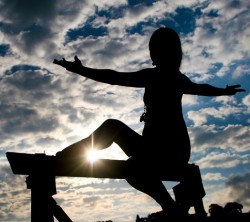“Come to the edge,” he said.
“No – it is too high,” I said.
“Come to the edge,” he said.
“No – I might fall,” I said.
“COME to the edge,” he said.
So I came to the edge
And he pushed me
And I flew [1]
There are valid reasons for fearing your edge—danger lurks there.
But so does growth.
If fear prevents you from playing your edge, that same fear is preventing you from learning, from progressing, from developing your full potential, including full health. How to play your edge, how to fly and avoid falling, and when to go past your edge—this is something a special teacher can show you.
It requires trust—of your teacher and trust of yourself.
In yoga the edge is the place of challenge and change. It may be high; it may be scary; but it is necessary. There are many kinds of edges: there is the physical edge, beyond which injury awaits; there is the emotional edge, beyond which tears and laughter blossom; there is the psychological edge, beyond which psychosis may erupt; there is the spiritual edge, beyond which freedom is found.
How and when to play these edges is worth investigating.
The Physical Edge
The body is always talking to us, if we would but only listen. In our physical yoga practice we are encouraged to approach the edge, which is the limit of tolerance of the tissues to the mechanical stresses being applied through the postures.
To go beyond our tissues’ tolerance invites damage and injuries. The body speaks, warning us of impending injuries, by sending us little “tweaks.” These small signals of pain or discomfort are important, and we ignore them at our peril, for little tweaks become big tweaks which suddenly turn into structural failure and long-lasting injury.
The body needs challenge to stay strong and healthy: too little stress and the tissues atrophy. However too much stress and the tissues degenerate.
If we fear our edge, we will default to a situation of too little, and that is too bad. If we ignore our edge, we will ignorantly go over the edge and fall into damage and decay.
 Playing the physical edges requires both attention and intention: the intention to be whole and healthy; attention to the body’s signals and sensations. In a yoga pose, we come to the point of challenge, our first edge, but then we back off a little. That first approach is a brief look over the cliff, to see what danger lurks there below if we wander too far.
Playing the physical edges requires both attention and intention: the intention to be whole and healthy; attention to the body’s signals and sensations. In a yoga pose, we come to the point of challenge, our first edge, but then we back off a little. That first approach is a brief look over the cliff, to see what danger lurks there below if we wander too far.
But our body is adaptable and our edges are living things: they change, if we respect them. Once we have approached the edge, checked it out, then backed off a little bit—not too far to where there is no challenge at all, but just enough so the edge is still in sight—the body relaxes.
When the body fully trusts, it will open; the edge will recede, inviting you to follow. In time (and it can be a very short time or a very long time—you will only know by paying attention) the edge moves and you may safely approach it once more, repeating the cycle of approach, observation, slight withdrawal, and patience, awaiting the next movement.
Your physical edge is not reached by worrying about your alignment, it is not reached by physical contortion; your edge is reached by paying attention to sensation. How you look is irrelevant; what is key is how you feel. Based on your feelings, you adapt, you adjust, you advance and you retreat. Alignment cues can guide you but they are never the ends, only one mean to finding your edge.
“And he pushed me …”
Under certain, specific and special circumstances your guide may push you beyond your physical edge. This may be beneficial in the right circumstances, but not in a classroom filled with many other students. A physiotherapist who knows you and your body well, a health care specialist who has taken the time to understand you, a healer who is working with you one-on-one: these guides may take you beyond—because sometimes to heal one must become injured again.
Scar tissue is an incomplete response to damage: to get to the place of total healing a therapist may have to push you past your comfort zone in order to break down the scars. Prolotherapy and other techniques, like scarring cartilage, can re-stimulate the body’s repair mechanism and allow the full healing to proceed. It is at times like these that we need to be pushed.
The Emotional Edge
Our body responds to emotions in observable ways, [2] and our emotions respond to our body. When we feel strong emotions we know that our body reacts: we feel flushed, tight, hot, butterflies, … But when we move our body, as we do in our yoga practice, we may also trigger emotional responses. There is a circular flow between the body and the heart/mind, well understood by the Daoists and yogis of India.
Cause and effect is a linear concept, which is a favorite Western map, but look beyond this map to the circularity of effect –> cause –> effect –> cause.
Our emotions cause bodily responses and our body’s movements cause emotional responses.
Just as we have physical edges beyond which we risk tearing open the tissues of the body, so too we have emotional edges beyond which we risk tearing open the heart. If the edge is pushed too fast and too hard, an emotional opening may become an emotional injury.
Pay attention! One reason you may not be able to go deeper in a posture may be due to an emotional edge: you may well be able to physically go deeper, but your heart knows that to go deeper may trigger an emotional crisis that you are not ready to face. Not yet. Play this edge too – approach it but then back off a little. Wait. In time, your heart may soften and you will be invited to come closer again. Your emotional edge may have moved and it may be safe to look once more over the precipice.
Never force the edge.
“And he pushed me …”
But even here, a dedicated guide may be very helpful, for there are times when emotionally we need to be pushed over the edge. When fear prevents our opening, when we are afraid to love or afraid to be angry, we avoid the edges. When our teacher knows us better than we know ourselves, and pushes us over the emotional edge, the fear is shattered and our hearts are free to love, free to anger, free to express the emotions we repressed.
The shock and joy of this sudden freedom from fear is expressed in joyous tears and uncontrolled laughter. We fly.
The Psychological Edge
“The mystic swims in the waters where the psychotic drowns.” [3] It is not surprising that, along with physical and emotional edges, we all have our psychological edges, beyond which there is an opening to the deep psyche, which our ego does not like to view. It is rarer in our yoga practices to approach these edges, but it does happen. If one is not prepared, a leap off this edge can lead to psychosis.
The ego will not willingly go there and a sign that the edge is close is a strong physical and emotional signal: a visceral sense of danger, of fear, a compulsion to withdraw. The edge is the place where our concepts change; we enter an alternate state of consciousness. The familiar is lost and the unfamiliar assaults us. We have gone too far.
Listen to that inner voice warning you that the edge is not to be passed. Back off again. Play the edge and view the abyss, but there is no need to dive in. Stay safe, stay grounded, and allow understanding to dawn slowly.
“And he pushed me …”
The shamans of primal cultures were guided through their psychosis by elders who had gone before them. In modern times, the psychosis of childhood and early adulthood are interrupted through chemical treatments: the journey interrupted. An experienced guide is not found in a yoga classroom: it is not here that the push will come. Unless you are being taught yoga privately by an experienced psychotherapist, continue to play this edge respectfully.
The Spiritual Edge
Each edge that we have visited holds potential danger and reward. This also applies to the final edge, the biggest edge of your life, the spiritual edge. Beyond this edge is freedom, but not freedom as we imagine it in the West. Our concepts are changed and the freedom offered is not a freedom to do what we want, but a freedom from want: no more wanting … anything! Are you ready for that? Probably not – few are.
Such a vast freedom will affect the social fabric of your life: you will see friends and family in the same way you see everyone else. That sounds scary, but think of it this way: you will see everyone else the same way you see friends and family. There will be no attachments, and there will be no detachments. Boundaries will cease to exist.
“And he pushed me …” Depending upon the spiritual map you have chosen and the guide who chose you, your journey may take you to the beatific sight or to a full absorption in the divine. There will be no self and other: the ultimate boundary your ego used to define itself will be lost. “Tat tvam asi,” said the sage: “You are it!” As you fly over the edge you see that there is only one reality and you are already in it.
Enjoy your flight.
**
References:
1. Adapted from Come to the Edge by Christopher Logue (1926 – 2011).
2. See this Finnish study on the physiological effects of emotions.
3. This sentiment was first expressed by Joseph Campbell. See Myths to Live By by Joseph Campbell.
Love elephant and want to go steady?
Sign up for our curated daily & weekly newsletters!
Editor: Renée Picard
Images: Yoga by Jean Wichinoski on Flickr / Tomas Sobek on Flickr / Carl Chapman on Flickr













Read 0 comments and reply